Colour Part 1
“The mind of the painter must resemble a mirror, which always takes the colour of the object it reflects and is completely occupied by the images of as many objects as are in front of it. Therefore you must know, Oh Painter! that you cannot be a good one if you are not the universal master of representing by your art every kind of form produced by nature. And this you will not know how to do if you do not see them, and retain them in your mind.”
Leonardo Da Vinci
from skimage import data
image = data.camera()
%matplotlib inline
import matplotlib.pyplot as plt
import numpy as np
fig, (ax_jet, ax_gray) = plt.subplots(ncols=2)
ax_jet.imshow(image, cmap='jet')
ax_gray.imshow(image, cmap='gray');
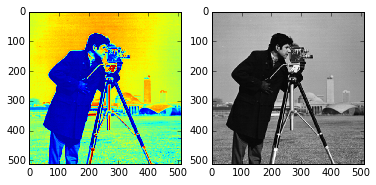
<matplotlib.figure.Figure at 0xaf27792c>
face = image[80:160, 200:280]
fig, (ax_jet, ax_gray) = plt.subplots(ncols=2)
ax_jet.imshow(face, cmap='jet')
ax_gray.imshow(face, cmap='gray');
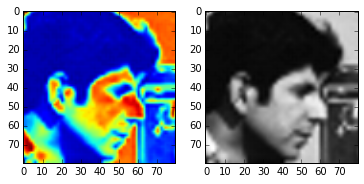
X, Y = np.ogrid[-5:5:0.1, -5:5:0.1]
R = np.sqrt(X**2 + Y**2)
fig, (ax_jet, ax_gray) = plt.subplots(1, 2)
ax_jet.imshow(R, cmap='jet')
ax_gray.imshow(R, cmap='gray');
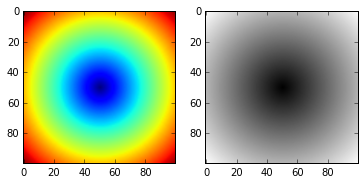
plt.rcParams['image.cmap'] = 'gray'
plt.rcParams['image.interpolation'] = 'nearest'
or
plt.imshow(R, cmap='gray', interpolation='nearest')
<matplotlib.image.AxesImage at 0xad87d92c>
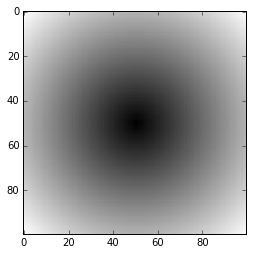
from IPython.html.widgets import interact, fixed
from matplotlib import cm as colormaps
@interact(image=fixed(face),
cmap=sorted([c for c in colormaps.datad.keys() if not c.endswith('_r')],
key=lambda x: x.lower()),
interpolation=['nearest', 'bilinear', 'bicubic',
'spline16', 'spline36', 'hanning', 'hamming',
'hermite', 'kaiser', 'quadric', 'catrom',
'gaussian', 'bessel', 'mitchell', 'sinc', 'lanczos'])
def imshow_params(image, cmap='jet', interpolation='bicubic'):
fig, axes = plt.subplots(1, 5, figsize=(15, 4))
axes[0].imshow(image, cmap='gray', interpolation='nearest')
axes[0].set_title('Original')
axes[1].imshow(image[:5, :5], cmap='gray', interpolation='nearest')
axes[1].set_title('Top 5x5 block')
axes[1].set_xlabel('No interpolation')
axes[2].imshow(image, cmap=cmap, interpolation=interpolation)
axes[2].set_title('%s colormap' % cmap)
axes[2].set_xlabel('%s interpolation' % interpolation)
axes[3].imshow(image[:5, :5], cmap=cmap, interpolation=interpolation)
axes[3].set_title('%s colormap' % cmap)
axes[3].set_xlabel('%s interpolation' % interpolation)
axes[4].imshow(R, cmap=cmap, interpolation=interpolation)
axes[4].set_title('%s colormap' % cmap)
axes[4].set_xlabel('%s interpolation' % interpolation)
for ax in axes:
ax.set_xticks([])
ax.set_yticks([])

color_image = data.chelsea()
print(color_image.shape)
plt.imshow(color_image);
(300, 451, 3)
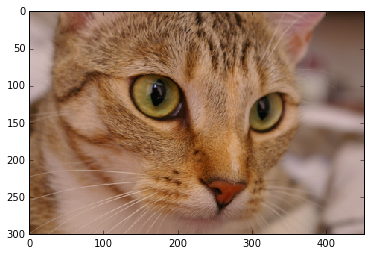
red_channel = color_image[:, :, 0] # or color_image[..., 0]
Note: red_channel = color_image[all_the_rows, all_the_cols, 0thchannel]
plt.imshow(red_channel);
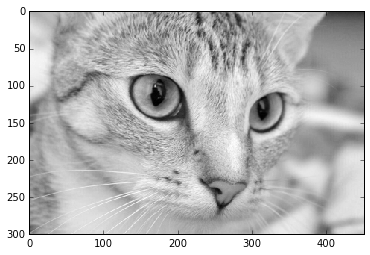
red_channel.shape
(300, 451)
from skimage import io
color_image = io.imread('../images/balloon.jpg')
import skdemo
red_image = np.zeros_like(color_image)
green_image = np.zeros_like(color_image)
blue_image = np.zeros_like(color_image)
red_image[:, :, 0] = color_image[:, :, 0]
green_image[:, :, 1] = color_image[:, :, 1]
blue_image[:, :, 2] = color_image[:, :, 2]
skdemo.imshow_all(color_image, red_image, green_image, blue_image)

Note: np.zeros_like(color_image) Return an array of zeros with the same shape and type as a given array.
color_patches = color_image.copy()
# Remove green (1) & blue (2) from top-left corner.
color_patches[:100, :100, 1:] = 0
# Remove red (0) & blue (2) from bottom-right corner.
color_patches[-100:, -100:, (0, 2)] = 0
plt.imshow(color_patches);
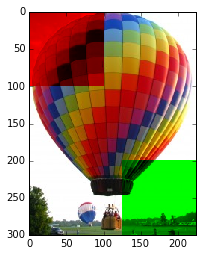
from skimage import io
src = io.imread('/home/cobalt/Pictures/geralt.jpg')
plt.figure(figsize = (16,8))
plt.imshow(src);

src_patches = src.copy()
col_by_3 = src_patches.shape[1]/3.
src_patches[:, :col_by_3, (1,2)] = 0
src_patches[:, col_by_3: 2*col_by_3, (0, 2)] = 0
src_patches[:, 2*col_by_3:, (0, 1)] = 0
plt.figure(figsize = (16,8))
plt.imshow(src_patches);

plt.figure(figsize = (16,8))
plt.hist(src.flatten())
(array([ 491741., 1156262., 589345., 415430., 436289., 755728.,
619180., 1219629., 519156., 18040.]),
array([ 0. , 25.5, 51. , 76.5, 102. , 127.5, 153. , 178.5,
204. , 229.5, 255. ]),
<a list of 10 Patch objects>)
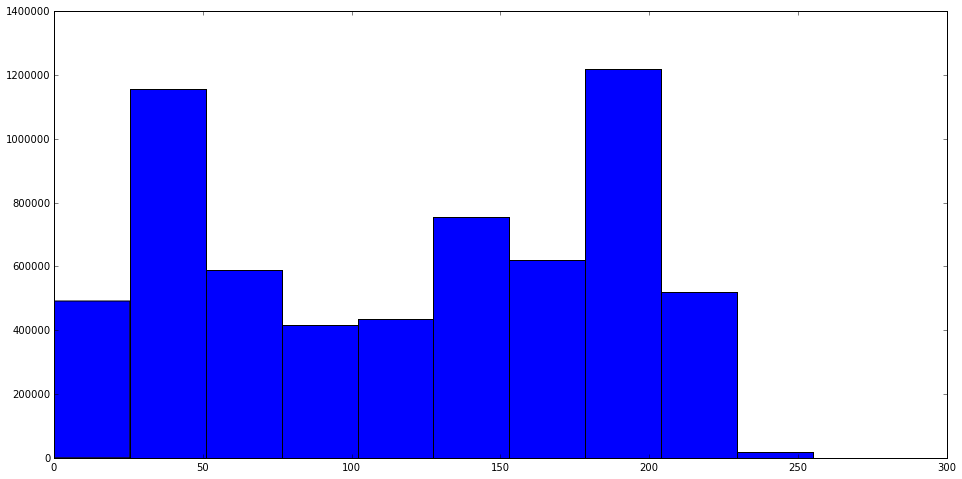
src.shape
(1080, 1920, 3)
np.rollaxis(src,axis=2).shape
(3, 1080, 1920)
for channel in np.rollaxis(src,axis=2):
print(channel.shape)
(1080, 1920)
(1080, 1920)
(1080, 1920)
plt.figure(figsize = (16,8))
for channel in np.rollaxis(src,axis=2):
plt.hist(channel.flatten())

Note: Wrong order
plt.figure(figsize = (16,8))
for color,channel in zip('rgb',np.rollaxis(src,axis=2)):
plt.hist(channel.flatten(), color=color, alpha=0.4)
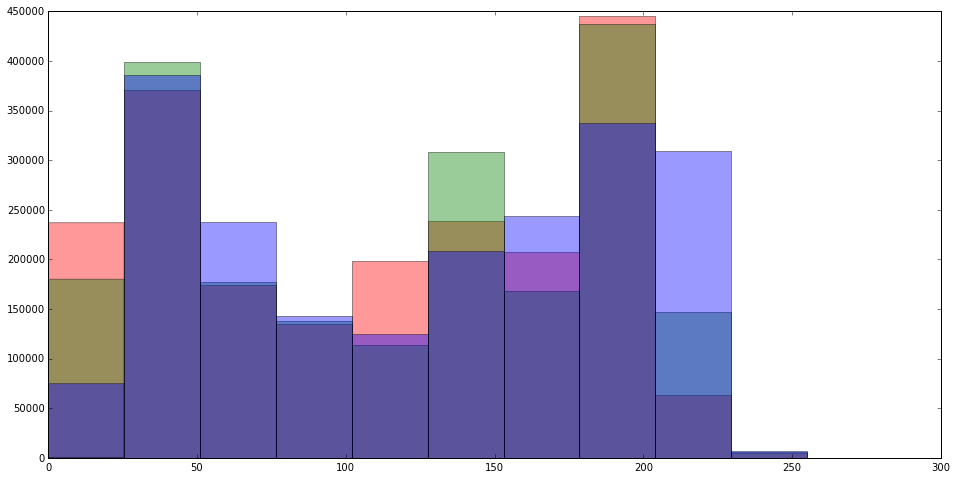
plt.figure(figsize = (16,8))
for color,channel in zip('rgb',np.rollaxis(src,axis=2)):
plt.hist(channel.flatten(), bins = 255, color=color, alpha=0.4)
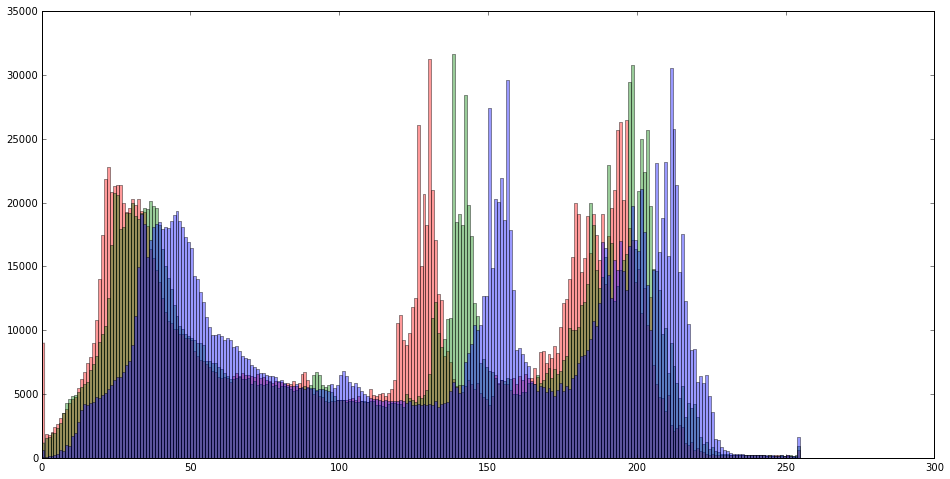
from skimage import exposure
plt.figure(figsize = (16,8))
for color,channel in zip('rgb',np.rollaxis(src,axis=2)):
freq, bin_centers = exposure.histogram(channel)
plt.plot(bin_centers,freq, color=color);
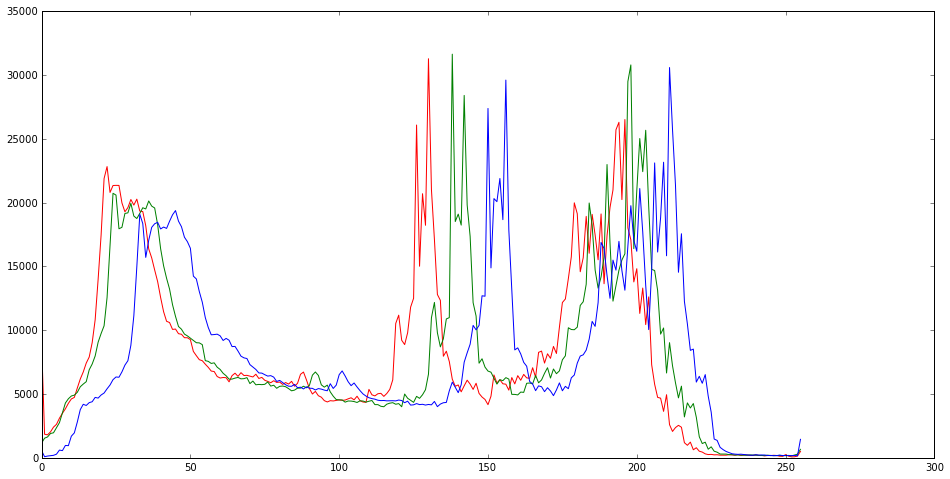
from skimage import exposure
plt.figure(figsize = (16,8))
for color,channel in zip('rgb',np.rollaxis(src,axis=2)):
freq, bin_centers = exposure.histogram(channel)
plt.fill_between(bin_centers,freq, color=color, alpha=0.4);
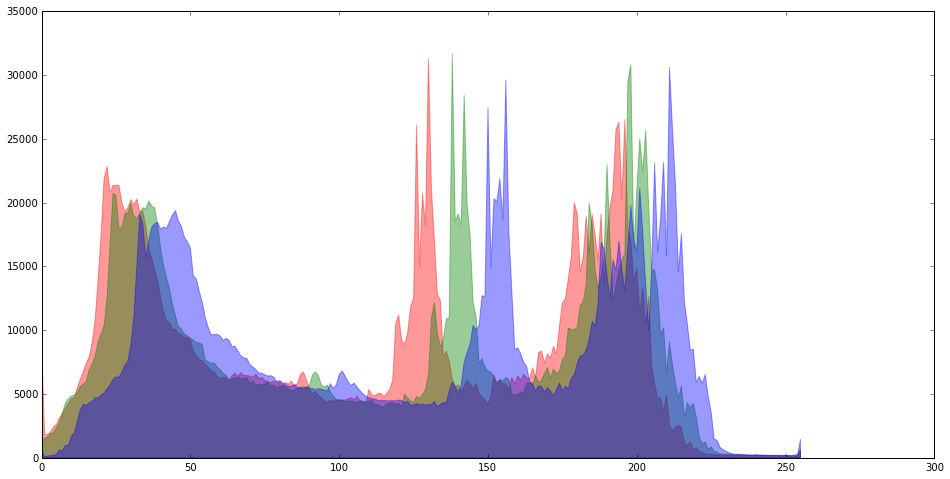
image = data.camera()
skdemo.imshow_with_histogram(image);
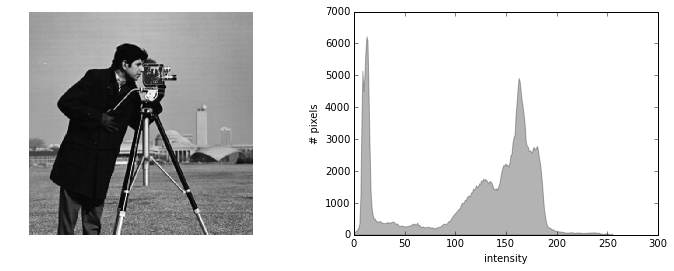
cat = data.chelsea()
skdemo.imshow_with_histogram(cat);

from skimage import io
src = io.imread('/home/cobalt/Pictures/geralt.jpg')
skdemo.imshow_with_histogram(src);

skdemo.imshow_with_histogram(data.lena());
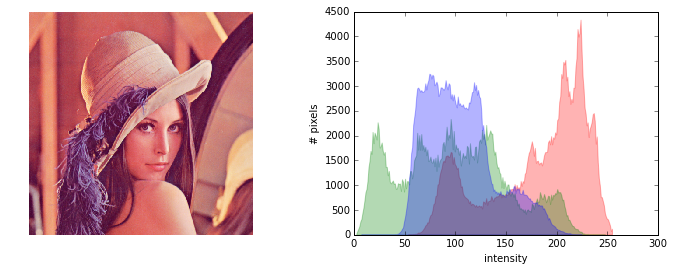
from skimage import io
src2 = io.imread('/home/cobalt/Pictures/marian.jpg')
skdemo.imshow_with_histogram(src2);
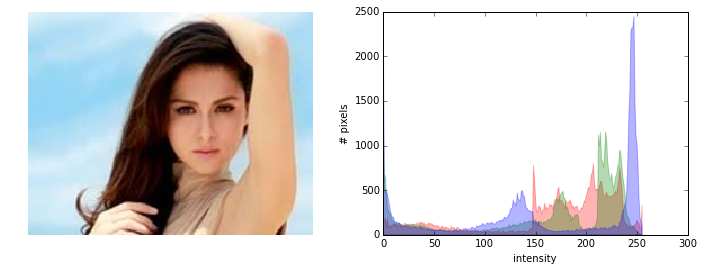
image = data.camera()
skdemo.imshow_with_histogram(image);
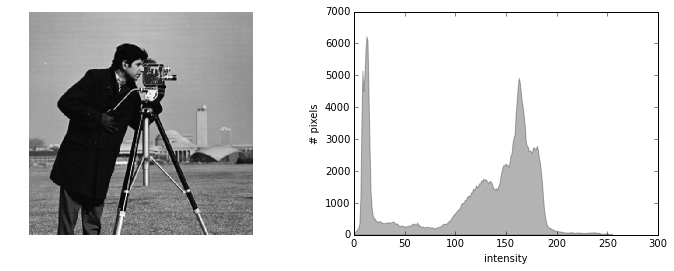
from skimage import exposure
high_contrast = exposure.rescale_intensity(image, in_range=(10, 180))
skdemo.imshow_with_histogram(high_contrast);

from skimage import exposure
high_contrast = exposure.rescale_intensity(image, in_range=(120, 180))
skdemo.imshow_with_histogram(high_contrast);
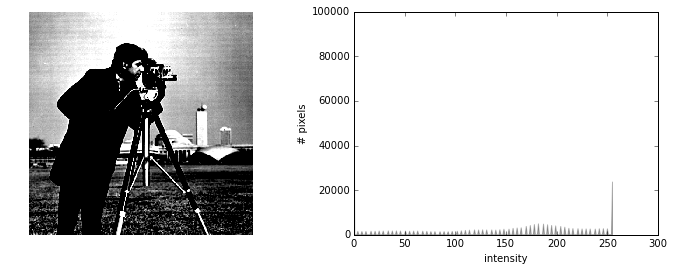
ax_image, ax_hist = skdemo.imshow_with_histogram(image)
skdemo.plot_cdf(image, ax=ax_hist.twinx())
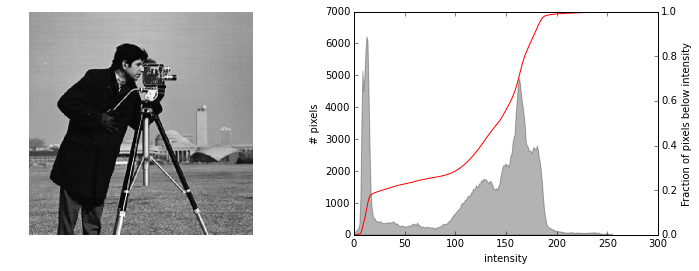
equalized = exposure.equalize_hist(image)
ax_image, ax_hist = skdemo.imshow_with_histogram(equalized)
skdemo.plot_cdf(equalized, ax=ax_hist.twinx())
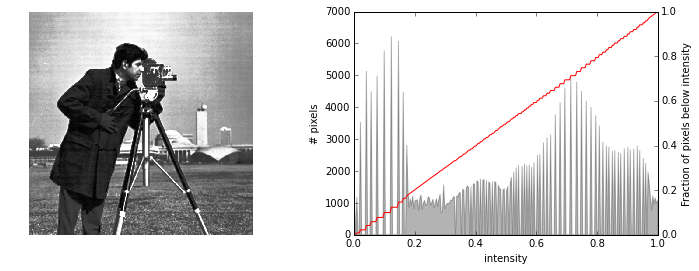
equalized.dtype
dtype('float64')
Unfortunately, histogram equalization tends to give an image whose contrast is artificially high. In addition, better enhancement can be achieved locally by looking at smaller patches of an image, rather than the whole image. In the image above, the contrast in the coat is much improved, but the contrast in the grass is somewhat reduced.
Contrast-limited adaptive histogram equalization (CLAHE) addresses these issues.
equalized = exposure.equalize_adapthist(image)
ax_image, ax_hist = skdemo.imshow_with_histogram(equalized)
skdemo.plot_cdf(equalized, ax=ax_hist.twinx())
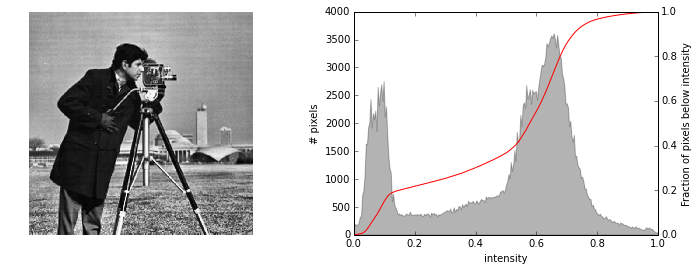
equalized.dtype
dtype('float64')
exposure.equalize_adapthist?
An algorithm for local contrast enhancement, that uses histograms computed over different tile regions of the image. Local details can therefore be enhanced even in regions that are darker or lighter than most of the image.
skdemo.imshow_with_histogram(image);
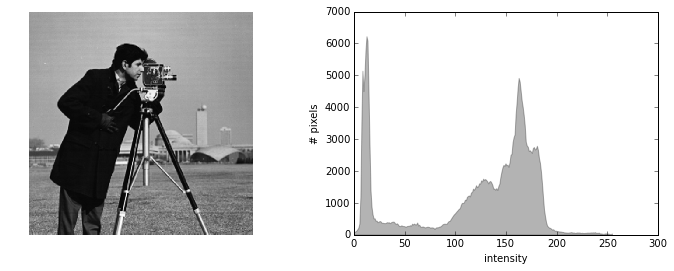
threshold = 50
ax_image, ax_hist = skdemo.imshow_with_histogram(image)
ax_image.imshow(image > threshold)
ax_hist.axvline(threshold, color='red');
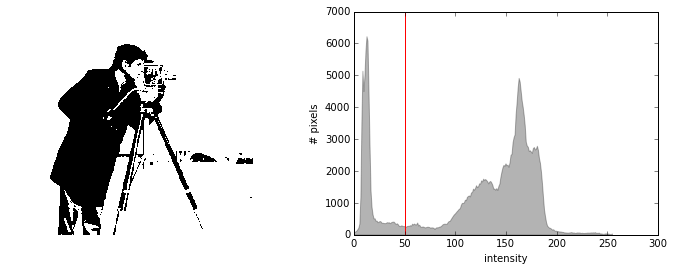
Note: the pants is not detected correctly.
import skimage.filters as filters
threshold = filters.threshold_otsu(image)
print(threshold)
87
plt.imshow(image > threshold);
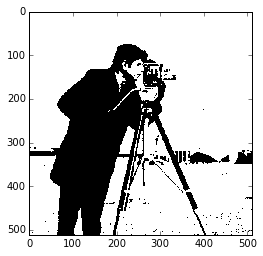
Reference:
[1] Juan Nunez Iglesias, Tony Yu, Image analysis in Python with scipy and scikit image 1 https://www.youtube.com/watch?v=MP-MTiCETYg
[2] http://scikit-image.org/